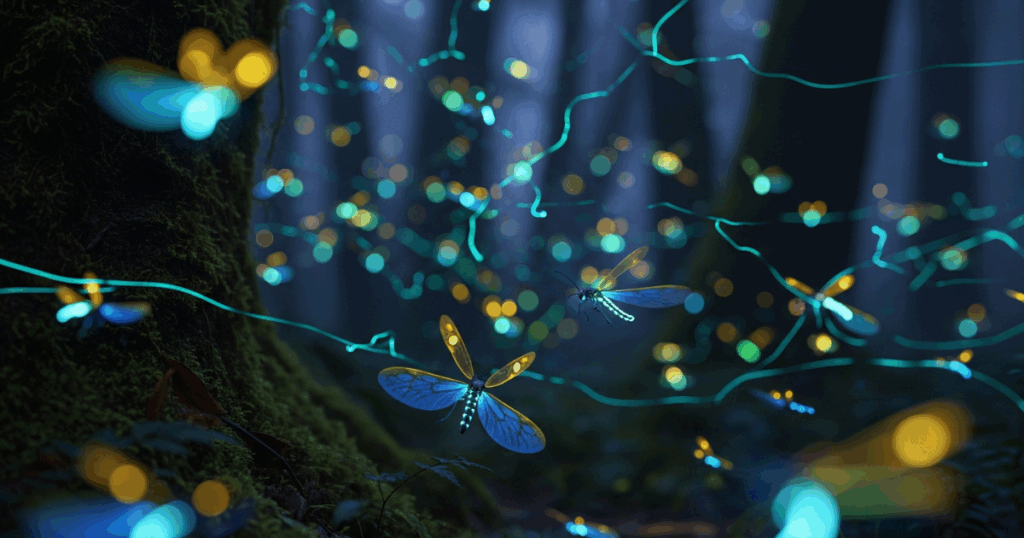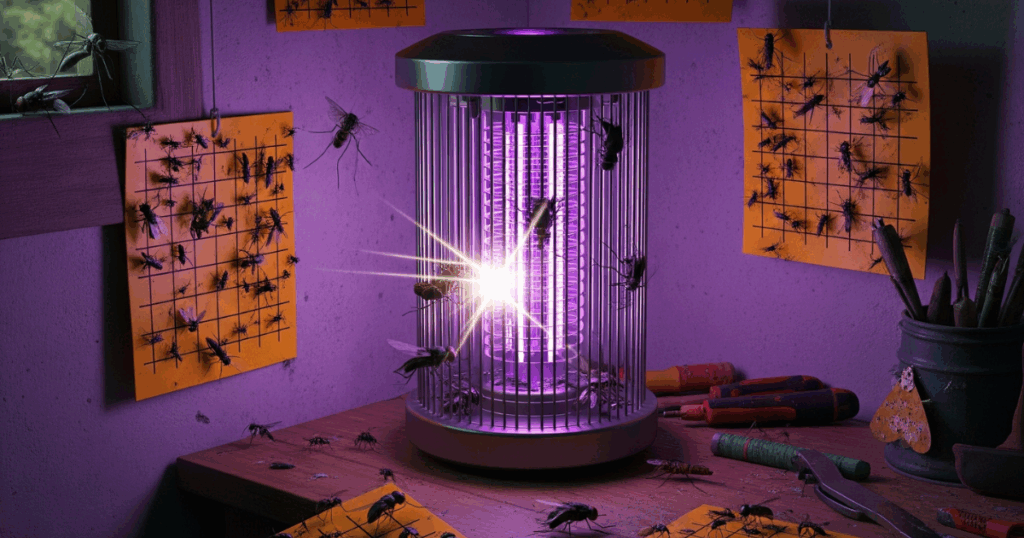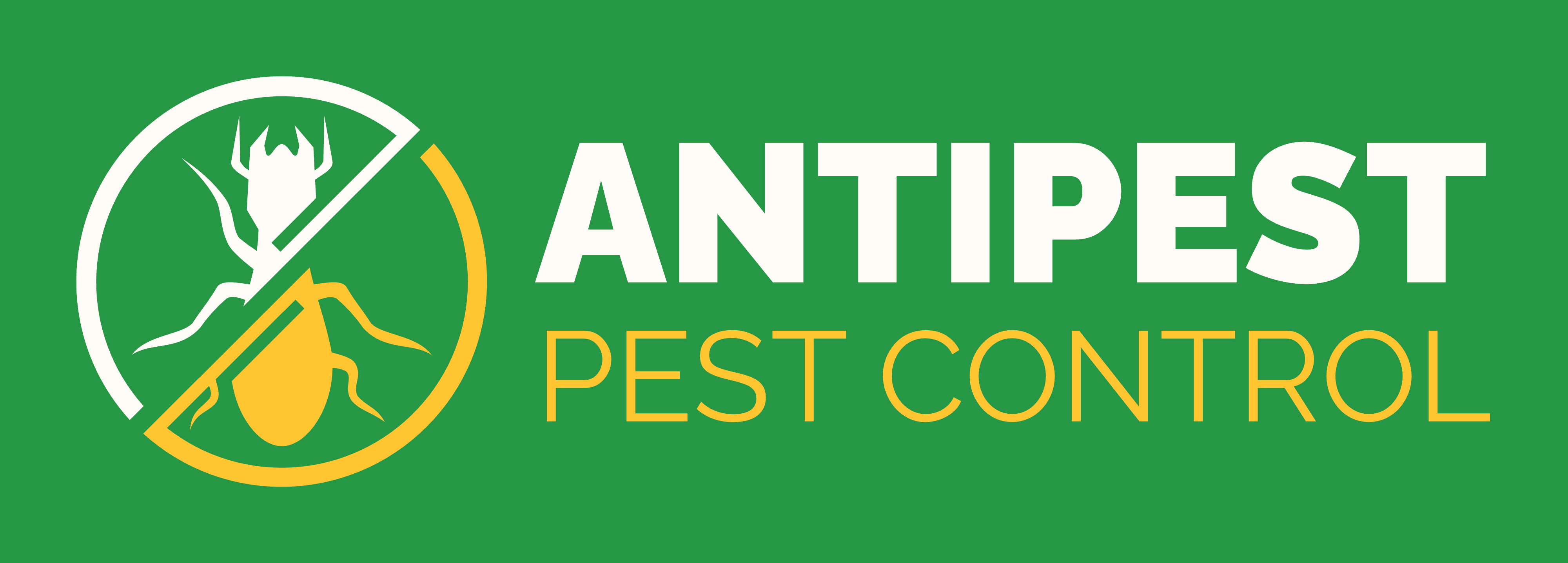When night falls, many homeowners discover a host of insects swarming around porch lights, street lamps, and indoor bulbs. If you’ve ever wondered how to get rid of insects attracted to light and reclaim your peaceful evenings, you’re not alone. Understanding how to get rid of insects attracted to light requires knowing why they’re drawn to illumination in the first place.
Whether you’re dealing with porch lights attracting massive swarms or indoor bulbs collecting flying nuisances, learning how to get rid of insects attracted to light effectively can restore your comfort and enjoyment. The good news is that with the right strategies and techniques, you can significantly reduce or eliminate these bothersome visitors without compromising your lighting needs.
Table of Contents
Why Insects Are Attracted to Light?

Understanding insect behavior is crucial when learning how to get rid of insects attracted to light effectively. Recent scientific research has revealed that insects don’t actually fly directly toward light sources as previously believed. Insects don’t fly toward lights intentionally – they experience disrupted navigation called the dorsal light response. This system evolved to use natural light sources for orientation.
Key Points:
- Insects orient their backs toward the brightest light source
- System evolved using sky as reference point
- Artificial lights become false navigation signals
- Creates trapped, repetitive flight patterns
Observable Behaviors:
- Spiraling and banking turns around lights
- Erratic flight and stalling
- Upside-down flying attempts
- Repeated collisions
Seasonal patterns affect insect activity:
- Spring: Emerging beetles and early moths
- Summer: Peak activity for most light-attracted species
- Fall: Late-season moths and flying ant swarms
- Winter: Indoor heating attracts cold-seeking insects
Why This Matters: Understanding this science helps choose effective methods for how to get rid of insects attracted to light by eliminating false navigation signals rather than just repelling insects.
Top Reasons Insects Are Attracted to Light
| Reason | Explanation |
| Navigational confusion | Mistake lights for the moon or sky and lose direction |
| Dorsal light response | Tilt backs toward light, leading to endless circular flight |
| Heat emission | Warm bulbs attract insects seeking warmth (for some species) |
| UV light mimicry | Light bulbs emit UV rays, similar to flower nectar signals |
| Predator/mating cues | Some bugs use lights to find prey or mates, increasing numbers |
Common Insects Attracted to Light

When developing strategies for how to get rid of insects attracted to light, identifying the specific species helps determine the most effective approach. Different insects exhibit varying levels of light attraction and respond differently to elimination methods. Knowing which insects gravitate toward your lights can help you target prevention efforts more effectively. Here are some of the key offenders:
- Moths: Renowned for erratic orbiting and collisions near bulbs.
- Mayflies: Swarm in large numbers, especially near water and light.
- Beetles: Many species, including ground and leaf beetles, are drawn to bright light.
- Mosquitoes: Some species hover near lights, especially if warmth or water is nearby.
- Flies: Flies and midges frequent illuminated spaces, particularly in summer.
- Thrips & Stink Bugs: Often found buzzing around indoor and outdoor lights.
Most Common Insects Attracted to Light
| Insect Type | Seasonality | Health Risk | Typical Attraction Point |
| Moths | Spring-Summer | Low | Porch lights, bulbs |
| Mayflies | Spring-Early Fall | Low | Outdoor lamps |
| Beetles | Summer | Low | Windows, patios |
| Mosquitoes | Summer-Fall | Moderate | Near water, bulbs |
| Flies/Midges | Summer | Moderate | Kitchen, porch lights |
| Thrips/Stink Bugs | Spring-Summer | Very Low | Indoor bulbs, entryways |
How to Get Rid of Insects Attracted to Light? – 5 Easy Steps
Banishing light-loving bugs doesn’t have to be complicated. Follow these proven strategies to keep insects away from lights in your homeand garden:
1. Switch to Yellow or Warm-Coloured Lights

Yellow bulbs and sodium vapor lamps emit a spectrum that’s much less attractive to insects. Unlike standard white or blue bulbs, yellow and warm LEDs drastically reduce bug invasions. LEDs with a narrow spectrum further minimize insect congregation by avoiding UV emissions.
2. Optimize Light Placement
Move outdoor lights farther from seating areas or doorways to lure insects away from where you gather. If possible, position bulbs at least 20m from entry points, especially for porch or garden lighting.
3. Install Physical Barriers and Screens

Fit fly screens on windows and doors and use screened enclosures for patios and decks. These barriers prevent flying bugs from getting inside, especially when indoor lights are on.
4. Use Essential Oils and Natural Repellents

Create a spray using peppermint, eucalyptus, tea tree, or lavender oils. These scents deter mosquitoes and other flying insects when spritzed around lights or doorframes. Citronella candles are also effective.
5. Employ Bug Zappers or Traps

Set up bug zappers or light traps near outdoor bulbs to capture and kill insects before they enter your home. For indoor areas, bug traps can significantly reduce the presence of pests without the need for chemicals.
Comparison of Bulb Types for Insect Prevention
Choosing the right type of light bulb can significantly reduce the number of insects gathering around your home, garden, or patio. Insects are naturally attracted to certain light wavelengths, and different bulb types emit varying levels of these wavelengths. Understanding which bulbs are less attractive to bugs can help you keep your space pest-free.
| Bulb Type | UV Output | Heat Output | Insect Attraction | Energy Efficiency |
| White/Blue CFL | High | Moderate | High | Moderate |
| Yellow LED | Very Low | Very Low | Very Low | High |
| Sodium Vapor | Low | Moderate | Low | Moderate |
| Halogen | High | High | High | Low |
Additional Strategies on How to Get Rid of Insects Attracted to Light?
Improving your results often means combining several practical methods. Here are more actionable insights to amplify your bug-control efforts:
- Turn Off Unnecessary Lights: Minimize outdoor and indoor lighting when not in use, especially during peak bug activity times, dusk and early evening.
- Seal Entry Points: Inspect and repair cracks around windows, doors, and walls using caulk or weather-stripping to block bugs looking for light sources inside.
- Remove Standing Water: Eliminate puddles, planters, and leaky faucets near lights to thwart bugs, notably mosquitoes, from breeding near illuminated areas.
- Tint Window Glass: Applying a tint or using blackout curtains dampens indoor light brightness, helping to keep phototactic insects outside.
- Use Fake Light Sources: Place a bright bulb or lamp away from high-traffic areas to lure pests well away from festivities or entryways.
How to Get Rid of Insects Attracted to Light from Returning?
Achieving lasting control requires ongoing vigilance:
- Adopt a lighting strategy: Invest in bulbs designed especially to repel insects. Opt for yellow spectrum, LED, or sodium vapor models.
- Regularly maintain barriers: Screened windows, tight seals, and closed doors during nighttime ensure bugs don’t follow light indoors.
- Monitor for moisture: Drain any standing water around lights, planters, buckets, and pet dishes are common sources.
- Consistent cleaning: Sweep away dead bugs and debris close to outdoor lights. Clean light fixtures to avoid buildup that may attract more bugs.
- Timely repairs: Fix torn screens, broken seals, and leaky pipes promptly.
These habits, practiced routinely, will ensure that insects attracted to light don’t become regular guests in your home.
Steps to Prevent Insects Attracted to Light
| Step | Frequency | Effectiveness | Safety Note |
| Change bulbs (yellow/LED) | Annually | High | No risk |
| Install screens | Once, check yearly | Very High | Ensure proper fit |
| Spray essential oils | Weekly | Moderate | Avoid on skin/eyes |
| Remove standing water | After rain/weekly | Very High | Watch for mosquito eggs |
| Use fake light sources | As needed | Moderate | Keep away from living Areas |
Maintenance Checklist for Light-Induced Bug Prevention
| Action | Recommended Frequency | Notes |
| Bulb check | Monthly | Replace with warm spectrum |
| Screen inspection | Semi-annually | Repair tears/faults |
| Water removal | After rainfall | Drain puddles and planters |
| Clean fixtures | Monthly | Avoid buildup |
| Entry inspection | Quarterly | Check for cracks/gaps |
Long-Term Prevention Methods
Developing sustainable approaches to how to get rid of insects attracted to light requires ongoing maintenance and environmental management. Establish regular cleaning schedules for light fixtures, removing dead insects and debris that might attract scavenging species.
Landscape design choices significantly impact insect attraction to your property. Plant insect-repelling herbs like basil, lavender, and mint near outdoor lighting areas. Avoid flowering plants that bloom at night near light fixtures, as these can increase overall insect activity in those areas.
Seasonal maintenance checklist:
- Spring: Replace burned-out bulbs with insect-resistant options
- Summer: Clean fixtures monthly and maintain water traps
- Fall: Seal entry points before insects seek winter shelter
- Winter: Plan lighting upgrades and screen repairs
| Prevention Strategy | Timeline | Effectiveness Duration |
| Yellow bulb installation | Immediate | Permanent |
| Screen maintenance | Seasonal | Annual |
| Essential oil treatments | Weekly | 7-10 days |
| Professional treatments | Monthly | 30-60 days |
“Want to get rid of weevils fast? Here’s how.”
Conclusion
Learning how to get rid of insects attracted to light is about more than comfort; it’s about making your living space safer, cleaner, and more welcoming. Maintaining a vigilant routine to keep pests at bay will make your home peaceful and bug-free. Take control of your lighting environment and enjoy evenings free from buzzing insects. Remember, how to get rid of insects attracted to light starts with proactive changes, and a commitment to keeping your living spaces illuminated, but not infested.
For comprehensive and hassle-free light insect removal and long-term pest prevention, trust the professionals at Antipest Office. Visit us at the Antipest Office, Our trained technicians use safe and effective methods to protect your home and business. For service bookings and consultations, call us at +91 9819018398 .
How to Get Rid of Insects Attracted to Light? – FAQs
How to get rid of insects attracted to light naturally without chemicals?
Use yellow LED bulbs, essential oil sprays, citronella candles, and soapy water traps. These natural methods are pet-safe and effective.
How to get rid of insects attracted to light using household items?
Place soapy water under lights, spray garlic solution, use coffee grounds as barriers, and burn citronella candles for deterrence.
How to get rid of insects attracted to light permanently?
Install yellow LEDs, add mesh screens, seal entry points, and eliminate breeding sites. Consistent prevention ensures lasting results.
How to get rid of insects attracted to light without turning them off?
Switch to yellow bulbs, use motion sensors, install window tinting, and position lights away from seating areas.
How to get rid of insects attracted to light during summer months?
Increase cleaning frequency, use essential oil barriers, place water traps, and apply professional treatments around fixtures.
How to get rid of insects attracted to light on outdoor patios?
Install screens, use positioned bug zappers, apply citronella treatments, and replace white bulbs with amber alternatives.
How to get rid of insects attracted to light that keep returning?
Target breeding sites, seal gaps, use professional treatments, and maintain year-round prevention. Address root causes consistently.
How to get rid of insects attracted to light using LED technology?
Choose warm-spectrum LEDs (2700K-3000K), avoid UV-emitting bulbs, and use dimmable systems for reduced insect attraction.
How to get rid of insects attracted to light in humid climates?
Increase ventilation, use dehumidifiers, apply citrus-based deterrents daily, and focus on moisture elimination strategies.
How to get rid of insects attracted to light when DIY methods fail?
Contact professional pest control for species identification, targeted treatments, and specialized equipment for persistent infestations.

